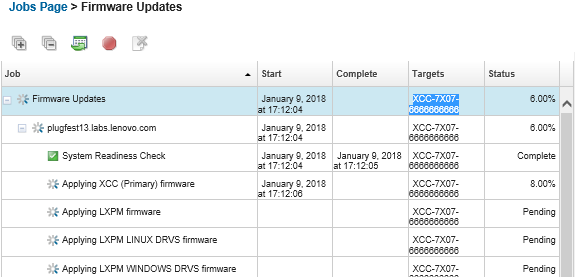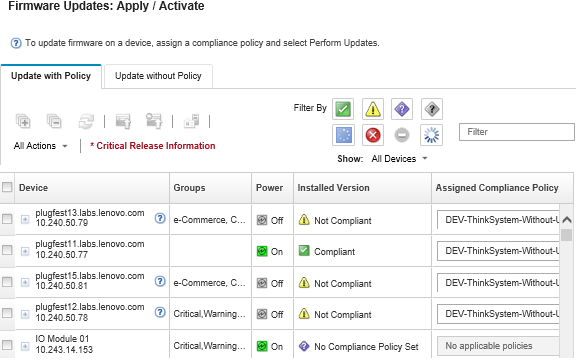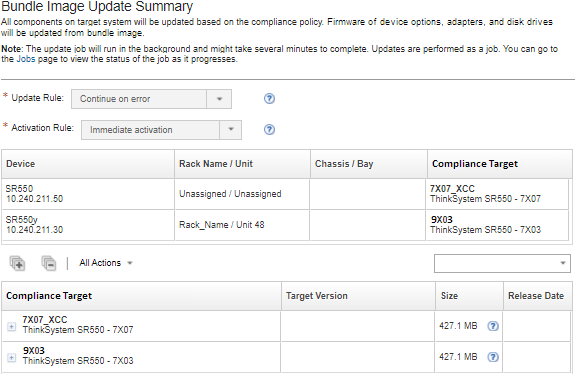Applying bundled firmware updates using compliance policies
After Lenovo XClarity Administrator identifies a managed device as not compliant, you can manually apply firmware updates to all components in selected ThinkSystem SR635 and SR655 servers that are not compliant with the assigned firmware-compliance policy using a bundled image that contain the applicable firmware update packages. The bundled image is created during the update process by collecting all firmware-update packages from the compliance policy.
Before you begin
- Read the firmware-update considerations before you attempt to update firmware on your managed devices (see Firmware-update considerations).
- Initially, devices that are not supported for updates are hidden from the view. Devices that are not supported cannot be selected for updates.
- By default, all detected components are listed as available for applying updates; however, down-level firmware might prevent a component from appearing in inventory or reporting full-version information. To list all policy-based packages that are available for you to apply updates, click , and selecting Enhanced Support for Down-Level Devices. When this option is selected,
Other Available Software
is listed in the Installed Version column for undetected devices. For more information, see Configuring global firmware-update settings.NoteThe global settings cannot be changed when updates to managed devices are in progress.
It takes a few minutes to generate the additional options. After a few moments, you might need to click the Refresh icon (
 ) to refresh the table.
) to refresh the table.
- Ensure that no jobs are currently running on the target server. If jobs are running, the update job is queued until all other jobs have completed. To see a list of active jobs, click .
Applying bundled firmware updates is supported only for ThinkSystem SR635 and SR655 servers.
Applying bundled firmware updates is supported only for IPv4 address. IPv6 addresses are not supported.
Ensure that each target device was booted to the OS at least once to retrieve the full inventory information.
Baseboard management controller firmware v2.94 or later is required to use the bundled-update function.
Only firmware updates from repository packs or individual firmware updates are used. UpdateXpress System Packs (UXSPs) are not supported.
- Only downloaded firmware updates are applied. Refresh the product catalog, and download the appropriate firmware updates (see Refreshing the product catalog and Downloading firmware updates).NoteWhen
XClarity Administrator is initially installed, the product catalog and the repository are empty. Compliance check is supported only for the baseboard management controller and UEFI in ThinkSystem SR635 and SR655 servers; however, XClarity Administrator attempts to apply firmware updates to all available hardware components.
Updates are applied according to the assigned firmware-compliance policy. You cannot choose to update a subset of components.
XClarity Administrator v3.2 or later is required to apply firmware updates for Lenovo XClarity Provisioning Manager (LXPM), LXPM windows drivers, or LXPM Linux drivers to ThinkSystem SR635 and SR655 servers.
The baseboard management controller and UEFI updates are skipped if the currently installed version is higher than the assigned compliance policy.
Firmware-compliance policies must be created and assigned to the devices on which you intend to apply firmware updates. For more information, see Creating and assigning firmware-compliance policies.
The selected devices are powered off before starting the update process. Ensure that any running workloads have either been stopped or, if you are working in a virtualized environment, moved to a different server.
About this task
The bundled-update process first updates the baseboard management controller and UEFI out of band. When these updates are complete, the process creates a bundled image of remaining firmware in the compliance policy based on the machine type. Then, the process mounts the image to the selected device and restarts the device to boot the image. The image automatically runs to perform the remaining updates.
You can update bundled-firmware on a maximum of 10 devices at one time. If you choose to update bundled firmware on more than 10 devices, the remaining devices are queued. A queued device is taken off the bundled-firmware update
queue when the activation completes on a device on which a bundled-firmware update was performed.
If an error occurs while updating a component in the device, the firmware-update process does not update the firmware for that specific component; however, the firmware-update process continues to update the other components in the device and continues to update all other devices in the current firmware-update job.
Procedure
To apply firmware updates in the form of a bundled image on managed devices, complete the following steps.
After you finish
When applying a firmware update, if the server fails to enter maintenance mode, attempt to apply the update again.
If updates were not completed successfully, see Firmware update and repository issues for troubleshooting and corrective actions.
From the Firmware Updates: Apply/Activate page, you can perform the following actions.
Export firmware and compliance information for each managed device by clicking .
NoteThe CSV file contains only filtered information in the current view. Information that is filtered out of the view and information in hidden columns are not included.Cancel an update that is being applied to a device by selecting the device and clicking the Cancel Update icon (
 ).NoteYou can cancel firmware updates that are in the queue to start. After the update process starts, the firmware update is cancelable only when the update process is performing a task other than applying the update, such as changing to maintenance mode or restarting the device.
).NoteYou can cancel firmware updates that are in the queue to start. After the update process starts, the firmware update is cancelable only when the update process is performing a task other than applying the update, such as changing to maintenance mode or restarting the device.View the status of the firmware update directly from the Apply / Activate page in the Status column.
Monitor the status of the update process from the jobs log. From the Lenovo XClarity Administrator menu, click .
For more information about the jobs log, see Monitoring jobs .

When the firmware-update jobs are complete, you can verify that the devices are compliant by clicking to go back to the Firmware Updates: Apply/Activate page, and then clicking the Refresh icon (
 ). The current firmware version that is active on each device is listed in the Installed Version column.
). The current firmware version that is active on each device is listed in the Installed Version column.

